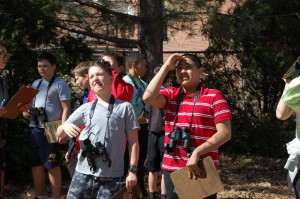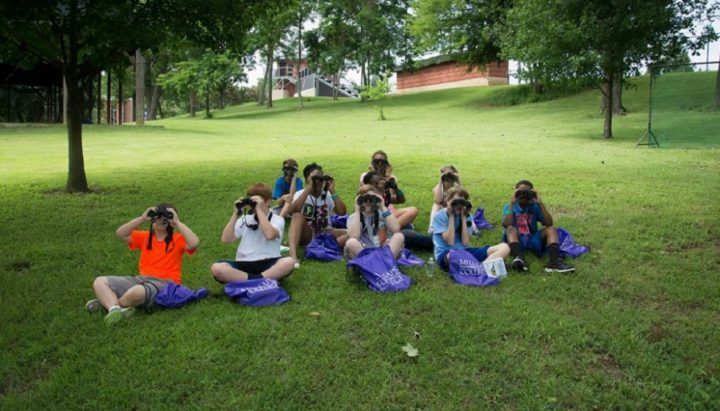Starting a Bird Club?
Why start a bird club?
What better way to get your students interested in birds than by forming a bird club at your school? Bird clubs can range from a small group to an entire class who engage in activities such as birding, studying bird biology, improving habitat for birds, and feeding birds in the schoolyard. Through bird clubs, we invite you to introduce students to birds and spark their curiosity about the natural world, help them discover a passion for science investigation, or start a hobby they can enjoy for the rest of their lives.
For this post, we talked to teachers and educators who have begun clubs at their schools. This is their advice:
First of all, don’t worry if you’re not a seasoned birder. You can learn along with the rest of the club! Learning how to find the answers is more beneficial to students than you telling students the answer to every single question. This kind of inquiry-based learning allows students to explore, discover, and find the answers themselves.

Students collecting data in the field. Photo by Katie Humason.
Planning for success
First, consider your goals for the club and how you might achieve them. What activities will you do? Which themes will you focus on? What will members of your club learn?
For example, your bird club might wish to focus on activities like:
- Citizen science
- Improving your schoolyard habitat
- Understanding bird biology
- Practicing birding and seeing as many birds as possible
- Art, sketching, nature journaling
- Field trips
Make it fun! Be sure to gauge what your students are curious about and what they want to get out of their bird club. Ask students for help in setting the goals and agenda. Let the kids take ownership of the club!
Meeting challenges head-on
One of the biggest challenges most instructors face when forming their bird club is finding the funds to subsidize supplies and field trips. You don’t need to have deep pockets to have a successful bird club. Donations are a great way to get your club off the ground. Parent groups, local stores, and supply vendors are often willing to provide donations of materials, funding, or in-person assistance to help jump-start your club.
Some materials can be gained through donation. Retail stores may throw away perfectly good bags of seed because they were ripped. Since they cannot sell the seed, ask if they will donate it to your school. It’s great publicity for the store, so make sure you and your club members send a thank-you note to them to display.

A home-made bird feeder can attract many species, like this Black-capped Chickadee. Photo by Phil Khaler.
If your options outside are limited, consider doing some indoor activities like dissecting own pellets or examining feathers. You can have members do bird-related art projects or make homemade bird feeds from common, easily attainable materials. Even just having a homemade bird feeder makes a huge impact on your kids’ interest in birds!
For older students, it may seem more difficult to get them excited about birds. But Gilroy High School teacher Jeff Manker disagrees:
“…young people are very anxious about the future of the planet, but don’t see much of a way to make a difference. I show them that their contributions to citizen science is a way to start that process. I link the birding we are doing, especially arrival and departure or absence of species with the fact that they can be key indicators of climate change. We have looked at the 2014 State of the Birds report to see if there were mentioned species in our area that we could be paying attention to. They take great pride and satisfaction in adding pieces of the puzzle if they think it reveals some information that is useful.”
K-12 recommendations
Our K-12 Resident Teacher Adviser, Barabara Jacobs-Smith started a very successful bird club, the Breck Birders, in Minnesota. Her advice for teachers just starting out:
“Make sure that the kids are actively involved in the club from the beginning. Let them give it a snappy title. Include kids when establishing the initial goals, rules, and expectations of the club. What do the students want to learn? What would they like to do? Establish clear expectations and consequences for the students involved that comply with school rules and student interest. Depending on the time of day when you meet, make sure you designate a student to bring in a snack for the club to enjoy!”
Bring in other teachers at your school who may have something to contribute to the club. The wood shop at your school could help you build bird houses or feeders; the art program could help when making bird-themed art. Some of your fellow teachers may have birding experience, or you could look into your local nature preserve or Audubon club for further assistance.
Make the bird club impact the students’ scientific inquiry and curiosity more through adding a bird habitat in the schoolyard. Some of our educators have had great success turning their schoolyard into bird-friendly paradises!
Helpful resources & activities
There are a lot of great resources available to help your plan and lead your bird club! Here are just some of our favorites:
- Our friends at Pennington Wild Birds have collaborated with us to develop their Feathered Friends curriculum, a free download resource to engage students and families in fun bird-themed activities.
- Attract breeding birds to your schoolyard by installing nest boxes! Build your own nest box and participate in NestWatch, the Lab’s nationwide monitoring program of breeding birds. We also have a free curricula around nesting birds.
- The Cornell Lab of Ornithology’s Youtube channel and its affiliates have a huge variety of footage about bird behavior, bird biology, and bird watching. Here are just a few for you to consider:
- Inside Birding is a wonderful series for beginners! These fun videos teach the basics of birding and offer helpful tips such as identification by size and shape, behavior, color patterns, and habitat.
- If your club members are using binoculars, this short video provides tutorial on the vital skill of how to properly focus them.
- The Birds-of-Paradise project allows for an amazing look at some of the most diverse and specialized animals on Earth, the Birds-of-Paradise. Also check out K-12’s free download, Evolution in Paradise.
- All About Birds is an online field guide to birds of North America. It is go-to reference for many birders wanting to know more about the species they encounter.
- Bird Academy focuses on fascinating biology and behavior of bird species through interactive games and modules.
- The Cornell Lab of Ornithology BirdCams are a great resource to give your club members an up-close look at nesting birds! Check out our Life in a Nest free download for lesson plans centered around the cameras.
- eBird is a terrific world-wide citizen science project and bird database sponsored by the Cornell Lab of Ornithology.
